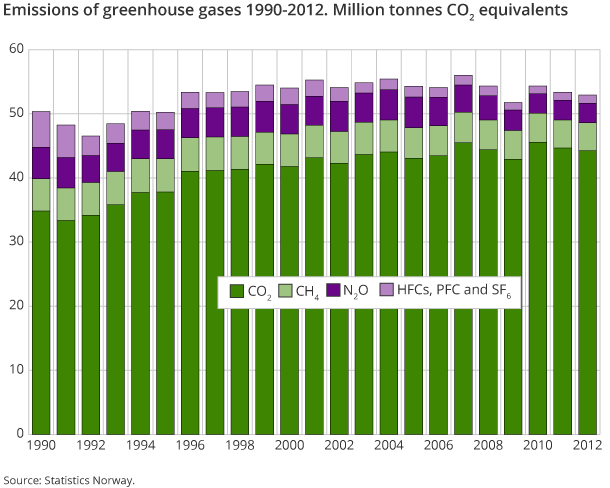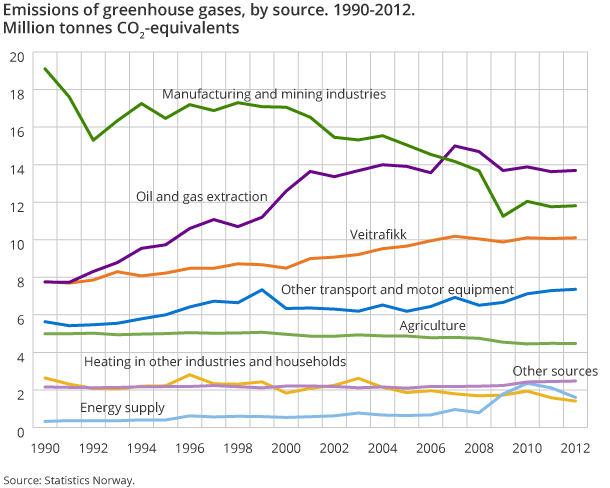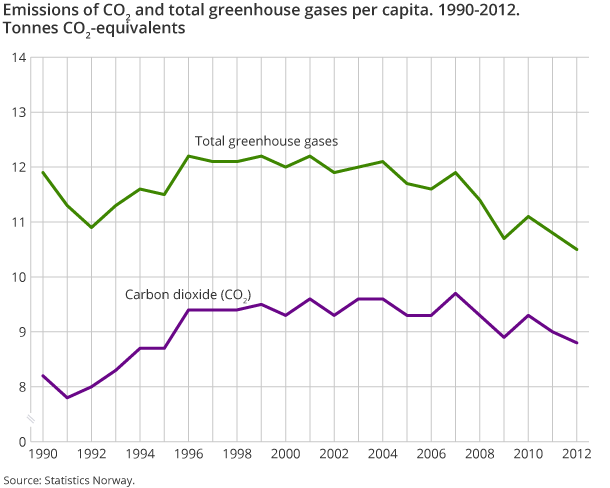Content
Published:
This is an archived release.
Lower greenhouse gas emissions in 2012
Preliminary figures on Norwegian domestic greenhouse gas emissions in 2012 amount to 52.9 million tonnes of CO 2 equivalents. This is 0.8 per cent less than the preceding year. Reduced emissions from power plants with low activity have contributed most to the decline.
| 2012 | Change in per cent | ||
|---|---|---|---|
| Since 1990 | 2011 - 2012 | ||
| 1Does not include international sea and air traffic. | |||
| Emissions from Norwegian territory | 52.9 | 5.1 | -0.8 |
| Oil and gas extraction | 13.7 | 76.7 | 0.5 |
| Manufacturing industries and mining | 11.8 | -38.2 | 0.4 |
| Energy supply | 1.6 | 393.5 | -24.1 |
| Heating in other industries and households | 1.4 | -46.7 | -11.2 |
| Road traffic | 10.1 | 30.1 | 0.4 |
| Aviation, navigation, fishing, motor equip. etc. | 7.4 | 30.6 | 0.9 |
| Agriculture | 4.5 | -10.3 | -0.2 |
| Other | 2.5 | 14.6 | 1.1 |
The preliminary emission figures show that 52.9 million tonnes of greenhouse gases were emitted from Norwegian territory in 2012. This is 0.4 million tonnes, or 0.8 per cent, less than in 2011. Apart from 2009, when the emissions were reduced because of low economic activity, the emissions are the lowest since 1995. Emissions per NOK produced (fixed prices), known as emission intensity, continued to drop. As in the preceding year, 2012 saw both a higher activity level in the Norwegian economy and a decline in greenhouse gas emissions. The emissions in 2012 were nevertheless 5.1 per cent higher than in 1990.
Lower emissions from energy supply
In 2012, emissions from energy supply were reduced by 24 per cent or 0.5 million tonnes of CO 2 equivalents, mainly as a result of very low activity at the gas power plants. Due to low electricity prices in 2011 and 2012, partly due to the record high production of hydro electricity, energy production at the gas power plants has not been profitable. Emissions from gas power plants will generally vary between years, as the activity is adapted to market conditions. In 2012, greenhouse gas emissions from energy supply amounted to 1.6 million tonnes of CO 2 equivalents, which corresponds to 3 per cent of the total Norwegian emissions.
Reduced heating emissions
In 2012, emissions from heating dropped by 11 per cent from the preceding year, and were the lowest in the period from 1990. This can also be explained by very low electricity prices in 2012, which made electric heating more attractive than the use of oil products. Heating emissions have been almost halved from 1990 and amounted to 1.4 million tonnes of CO 2 equivalents in 2012.
Higher emissions from oil and gas extraction
According to the Norwegian Petroleum Directorate, the production of oil and gas increased by 3 per cent from 2011 to 2012. This contributed to higher emissions from oil and gas production. Compared to the preceding year, the emissions rose by 0.5 per cent or 0.1 million tonnes of CO 2 equivalents, amounting to 13.7 million tonnes of CO 2 equivalents in 2012.
Since 2007, emissions from oil and gas extraction have been the major source of greenhouse gas emissions in Norway. Increased extraction and higher emissions from plants on shore in the period 1990-2012 resulted in the emissions in 2012 being 77 per cent higher than in 1990. This was nevertheless 9 per cent less than in the peak year 2007. In 2012, oil extraction and gas extraction were responsible for 26 per cent of the domestic greenhouse gas emissions, compared to 15 per cent in 1990.
Small emission rise for road traffic
A minor increase in fuel sales led to a corresponding rise in the calculated emissions from road traffic in 2012, which were 0.4 per cent higher than in 2011 and amounted to 10.1 million tonnes of CO 2 equivalents. This corresponds to 19 per cent of the total Norwegian greenhouse gas emissions. The changeover from petrol to diesel cars from previous years continued in 2012 and is reflected in the emission figures. Emissions from road traffic have increased by 30 per cent since 1990 due to the growing number of vehicles and increased mileage. However, more energy-efficient vehicles, a changeover from petrol to diesel (which causes lower emissions per km) and the addition of bio fuels, have all helped lessen the growth in emissions from road traffic.
Steady emissions from manufacturing industries
The total greenhouse gas emissions from manufacturing industries amounted to 11.8 million tonnes of CO 2 equivalents in 2012, which is at the same level as in 2011. These emissions stem partly from combustion and partly from industrial processes. Since 1990, greenhouse gas emissions from manufacturing industries have been reduced by 38 per cent. The decline in the period 1990-2012 is due to improved technology, less use of oil products and plant closures. The manufacturing industries’ share of total greenhouse gas emissions has been reduced from 38 per cent in 1990 to 22 per cent in 2012.
Emissions per capita
Emissions per capita of CO 2 and total greenhouse gases amounted to 8.8 and 10.5 tonnes of CO 2 equivalents respectively in 2012. Emissions per capita of total greenhouse gases have dropped by 11 per cent from 1990, whereas emissions per capita of CO 2 have increased by 7 per cent. The emissions per capita of CO 2 are at the same level as the average for nations in Western Europe.
International obligations and national targets on emission cutsOpen and readClose
Norway’s allocated emission quota from the UN amounts to 50.1 million tonnes of CO2 equivalents annually in the period 2008-2012. This is 1 per cent more than the domestic emissions in 1990. The emissions in 2008-2010 exceed the allocated annual amount.Norway can, however, fulfil the obligation by using three flexibility mechanisms: Joint Implementation, the Clean Development Mechanism and quota trading.
The emission inventory that is reported annually to the UN also includes emissions and sinks in forest and other land areas. According to the KyotoProtocol,Norwayhas an annual entitlement to be credited approximately 1.5 million tonnes from sinks in forests for the years 2008-2012.Norway’s policy, however, is that these sinks shall not be used to fulfil the Kyoto Protocol obligations.
In 2008, the majority in the Norwegian parliament entered into an agreement on a national target for emission reductions. The target is that domestic emissions shall not exceed 45-47 million tonnes of CO2 equivalents in 2020. This target was confirmed in a Report to the Storting in2012. In 2011, the emissions were 6-8 million tonnes above this national target.
Detailed information in February 2014Open and readClose
The figures presented here are preliminary, and revised figures will be published in February 2014, together with more detailed figures by source and economic sector.
This page has been discontinued, see Emissions to air, Annually.
Contact
-
Trude Melby Bothner
E-mail: trude.melby.bothner@ssb.no
tel.: (+47) 40 81 14 25
-
Berit Storbråten
E-mail: berit.storbraten@ssb.no
tel.: (+47) 40 81 14 23



